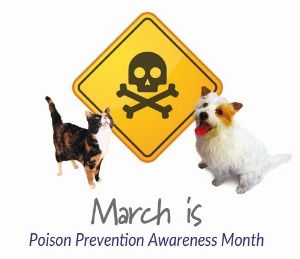Most pet parents know that chocolate and onions are dangerous for dogs, but did you know that antifreeze, lilies and grapes are hazardous for cats and dogs?
March is Poison Prevention Awareness Month, and Goodnewsforpets wants pet owners to be aware of the dangers to more than just themselves but their pets as well. Knowing what to properly secure and identify as potential hazards to pets is the smart way to practice pet safety in all areas of your home and beyond.
Flowers and Plants
 With Easter just around the corner, lilies will be abundant in your home and out so you must watch your pets since they can cause kidney failure in cats. Whether garden plants, houseplants, plants in the wild, or flowers from the florist — plants can provide a tasty and tempting diversion for animals. Some other potentially poisonous plants and flowers include:
With Easter just around the corner, lilies will be abundant in your home and out so you must watch your pets since they can cause kidney failure in cats. Whether garden plants, houseplants, plants in the wild, or flowers from the florist — plants can provide a tasty and tempting diversion for animals. Some other potentially poisonous plants and flowers include:
- Aloe Vera
- Amaryllis
- Azalea/Rhododendron
- Baby’s Breath
- Begonia
- Carnations
- Castor Bean
- Chrysanthemum
- Cyclamen
- Daffodil
- Gladiola
- Hosta
- Ivy
- Milkweed
- Morning Glory
- Oleander
- Poinsetta
- Pothos
- Sago Palm
- Tomato Plant
- Tulip/Narcissus
- Yew
Food
Watch out for the foods that are poisonous to dogs and poisonous to cats. The best way to avoid an issue with any of these foods is to keep humans foods closed away in your fridge or cupboards when you’re not in the room. Some notable people foods pets should avoid include:
- Chocolate
- Coffee
- Caffeine
- Alcohol
- Avocado
- Macadamia Nuts
- Grapes
- Raisins
- Yeast dough
- Eggs
- Xylitol
- Onions
- Garlic
- Chives
- Milk
- Salt
Household Products
Cleaning supplies, unsurprisingly, can be harmful to pets if ingested. Find out how to keep your pets safe from your cleaning supplies. Potentially dangerous household items include:
- Acids (such as drain and toilet cleaners)
- Alkalis (such as ammonia, lye and some types of drain and toilet cleaners)
- Batteries
- Bleach
- Enzymatic cleaners (used for breaking down proteins and organic matter)
- Fabric softeners
- Glow jewelry
- Ice melt products that contain sodium or salt-like ingredients
- Potpourri
- Mothballs
- Paint solvents and lacquers
- Paint balls
- Pine oil/essential oils
- Solvents (such as cleaners used to remove oil, grease and grime)
- Teflon-coated cookware
It’s important to note that poisons aren’t always ingested; some can be inhaled or even absorbed through the skin. As always your and your pet’s safety is paramount, knowing the how to identify potential dangers is key to practicing pet safety everyday.

